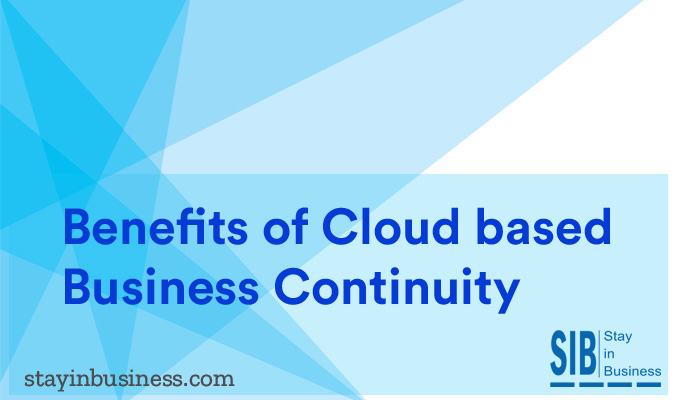
Cloud based business continuity has made achieving operational resiliency easier, faster and more economical. Organizations now have the luxury of tackling downtime – the bane of any business that can stall production and impact revenue – seamlessly. And the benefits for organizations who take business continuity to the cloud are immense.
This is especially true in the case firms that need uninterrupted data flow to ensure high productivity levels as even a few minutes of down time can impact revenue in the range of hundreds of thousands or even millions of dollars. Cloud based business continuity is reliability at an affordable cost.
Advantages of Cloud based Business Continuity over traditional methods
At the time of its inception, business continuity in the cloud was a costly service that only large corporations could afford. As more and more Cloud Service providers entered the market, competition increased, prices fell and became more affordable. Today, backing up data in the cloud is the norm rather than the exception, even for small businesses with longer RTO and RPO metrics.
Why Your Organization Needs Cloud Based Business Continuity and Disaster Recovery:
Availability – Businesses today can avail a cloud based business continuity solution even in remotely located areas. With a wide range of services on offer, your IT team can pick and choose the services that serve their business needs.
Cost effective – Cloud-based business continuity solutions are cost effective and affordable, even for small businesses. Companies have the option of customizing their solution by subscribing only to the services they need. As business operations expand, the subscription plan can be modified by adding or removing services. Cloud-based business continuity makes this type of on-call availability of services possible and eliminates the need for expensive off-site production facilities.
Easy back-ups –The confluence of cloud computing and business continuity has made it possible to backup data in real time or at scheduled intervals, thereby rendering night-time backups obsolete. This procedure can be automated and servers can be configured accordingly.
Easy to restore from the cloud – In the event of a disaster, recovery and restoration functions are easily done. Cloud based business continuity is 99% more reliable that more conventional backup options such as tapes, disks or flash drives where the probability of data corruption is high.
Can be accessed from anywhere – One of the biggest advantages of using the cloud for Business Continuity is that it can be accessed from anywhere in the event of a disaster. All that is needed is an internet connected device. Of course, security being a prime consideration, proper authentication procedures must be followed. If the production center is out of action, then authorized staff can work from home, hotels, convention centers etc. This wide accessibility gives IT Staff more breathing space to normalize functions and to ensure business continuity.
It should be cautioned at this juncture that the benefits of Cloud Based Business Continuity do not cover the entire gamut of BCDR. A careful study must be made of different disaster scenarios and their respective business impact. After taking all aspects of disaster possibilities into account, the business continuity and disaster recovery plan must be developed. It should be regularly tested and staff should be adequately trained.
Choosing the Right Cloud-based Business Continuity Plan
- Ensure that your organization’s business and technical teams reach a consensus on RTO and RPO values for the BCDR solution
- Sequentially categorize all data, systems and applications based on priority
- Document all processes, activities and tasks for review, reference and training
- Compare and contrast the cost vs. benefit for all available cloud-based BCDR solutions
- Test the prospective cloud solution in as many BCDR scenarios as possible before making the purchase
How to Implement a Cloud-based Business Continuity Plan
- Design a cloud solution that manages data hierarchically – Start with data storage, followed by backup and restore, and finally leveraging disaster recovery during a crisis
- Automate as much as possible, leaving very little margin for manual error
- Contract the services of an experienced cloud-based business continuity vendor and customize the solution to your specific needs
Disasters
[carousel id=’1780′ items=’4′ items_desktop=’3′ margin_right=’5′ navigation=’false’] [item img_link=”https://www.stayinbusiness.com/wp-content/uploads/2016/02/Chemical-Spills-Discharges.jpg” href=”https://www.stayinbusiness.com/resource/disaster-recovery/chemical-spills-and-discharges/”][item img_link=”https://www.stayinbusiness.com/wp-content/uploads/2016/02/Riots-Public-Disturbances.jpg” href=”https://www.stayinbusiness.com/resource/disaster-recovery/riots-and-public-disturbances/”][item img_link=”https://www.stayinbusiness.com/wp-content/uploads/2016/02/Terrorism.jpg” href=”https://www.stayinbusiness.com/resource/disaster-recovery/terrorism/”] [item img_link=”https://www.stayinbusiness.com/wp-content/uploads/2016/02/worst-product-recall.jpg” href=”https://www.stayinbusiness.com/resource/disaster-recovery/product-recall/”] [/carousel]


